Archives 2022
Let’s Focus on the Secret Lines of Force!
Zsolt Szász: The idea to thematise these festivals has presented itself with the organisers of Madách International Theatre Meeting year after year. In 2013, when planning the first festival programme, we thought that the event should be a forum for national theatres and we should start getting to know one another by presenting a drama emblematic of each nation. In it, beyond our curiosity, there was an element of defiance, too, because we wanted to prove that opinion leaders holding that national theatres were, by definition, conservative, anachronistic and uninnovative were not right. However, it turned out that Poland had a festival of this kind already, so we tried to find a new path. Nevertheless, the professional programmes during MITEM 1 and 2 had the current state and responsibility of national theatres as their central theme. We also undertook public debates on the topic with representatives of, for instance, Burgtheater from Vienna or Thalia from Hamburg. Now, after the fourth festival, we can say that our practice has proven effective: instead of imposing conceptual thematisation, we prefer to focus on those secret lines of force which provide a true picture of the changing world and the current state of theatre culture through the invited productions year by year. The openness of our philosophy, that it is not only the most famous professional stone theatres which may represent theatrical elite but so are prospering independent companies, has been justified. This year’s MITEM was advertised by the slogan “World-Famous Directors, Celebrated Performances”, with megaproductions as well as small theatre and solo productions featuring in its programme.

Ágnes Pálfi: It was not before the fifth day of the festival that we came to realise that nearly all of the latter productions were variations on the theme of death. Although the opening street theatre performance by the stilt-walking actors from Teatro Tascabile, Bergamo, fell victim to the stormy weather, the parts performed in the theatre lounge still implied that the emblematic dance of bourgeois Europe, the waltz, gives the impression of some nostalgic and elegiac dance of death today. This reading was also reinforced by their production Rosso Angelico two days later, as an unequivocal persiflage of the shared grand European tradition of the genre of the danse macabre.
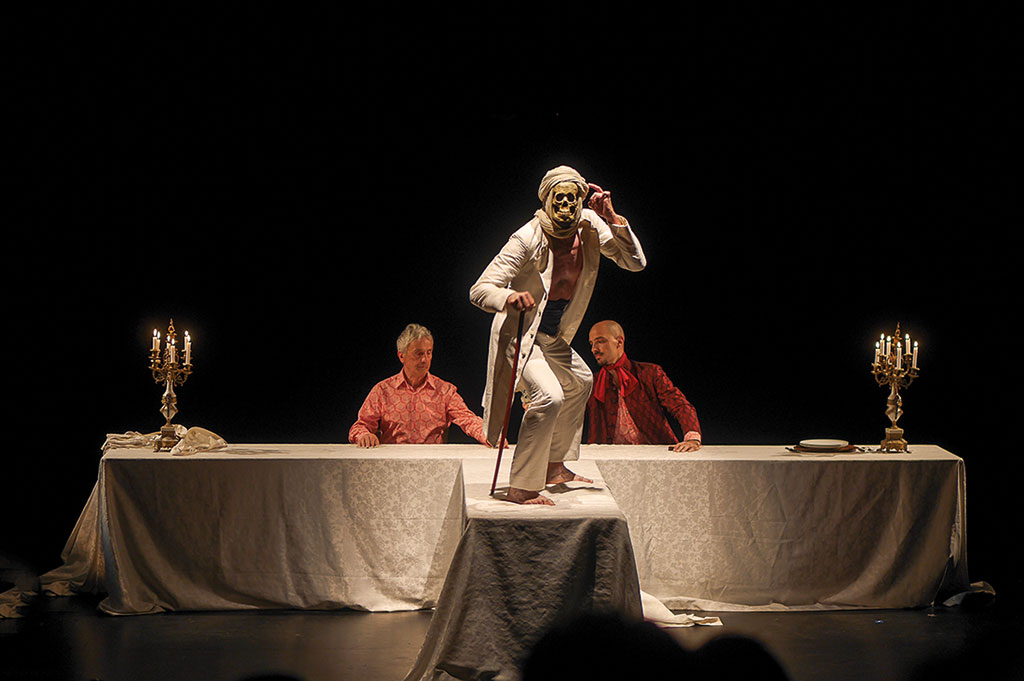
Zsolt Szász: It is important for us to know that the company founded by Renzo Vescovi has been one of the most significant representatives of theatre anthropology associated with Eugenio Barba and Nicola Savarese. In the production dedicated to the memory of the founding director, the spirit of Eastern tradition was alloyed with European tradition at such a high standard as unparalleled even at this illustrious festival.
Ágnes Pálfi: And yet I, as a member of the audience, was not simply impressed by their technical skills but also by their personalness which made me believe that “nice death”, endorsed by Eastern philosophies, does in fact exist.
Zsolt Szász: At the meet-the-artist event, the artistic director of the company, Tiziana Barbiero emphasised that they – unlike Odin – never use an inset by an oriental artist in their productions. Instead, they just scrutinise the spiritual surplus in oriental thought and harmonise it with their own, rooted in the spirit of European Christianity. We noted this distinction because for six months prior to MITEM we were publishing in Szcenárium Barba’s essays on nothing but the chances of synthesizing European and Eastern theatrical art.
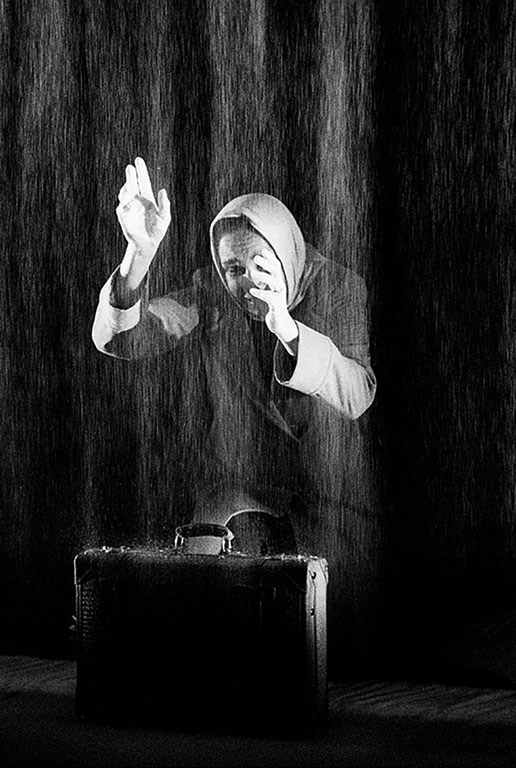
Denmark, d: Eugenio Barba, with Roberta Carreri in the photo (by Tony D’Urso)
Ágnes Pálfi: Julia Varley’s performance called a ritual, Ave Maria, commemorates an actress, while Roberta Carreri’s solo production (or rather duo, on account of the presence of Jan Ferslev through a complex sound montage), Salt, I think is a personal confession about the road she travelled as an actor, inspired by Antonio Tabucchi’s short story. However, both initiate the viewer into the mystery of life after death and reflect the elemental yearning in man to take possession of his own death. Actually, the very function of death dance originating from the Middle Ages is to have us consider death as part of our life rather than some remote fatal event. In fact, theatre itself has been maintained by this primordial drama because it alone is able to make evident to our senses the paradox that while breathing new life into the dead on stage, the actor himself seems to belong to that other world already. Take Tadeus Kantor, who placed this paradox into the focus of his aesthetics. Roberta Carreri sensualises the permeability of the borders of existence in an astonishingly suggestive manner when she closes the seance with the image of the floating masque of her own face appearing through the screen of salt, like a delicate veil of water, trickling down and down.

Zsolt Szász: In the course of celebrating her “service”, Julia Varley chose an entirely different way of theatralising the death theme. The performance dedicated to the memory of Chilean actress Maria Cánepa, who fought against Pinochet’s regime, is a sort of puppet representation because Julia Varley is present hiding in a giant puppet during the first and last third of the production, plus her face remains masqued in the second third, too. The skeleton donned on herself is meant to evoke the dead Maria as live, apparently indicating that in South America the commemoration of the ancestors, the day of the deceased, with enflowered skeletons and colourfully painted skulls, is the greatest holiday of all. Unfortunately, for me as a puppeteer familiar with the way the genre works, this indirect manner of communication characterising the whole performance thwarted the reception of the drama in the two actresses’ personal relationship and the quiet sorrow of remembrance. However, I found Eugenio Barba’s masterclass with Julia Varley, which was the third, open rehearsal of Red, Odin’s production in the making, immensely convincing. The Maestro used some poetic prose by Borghes to demonstrate his working method: he had the actress “act out” her free associations arising in the wake of the active verbs in the text. This mimetic sequence of gestures gradually formed an etude in its own right, which did not illustrate the story but re-wrote it in another language.
Ágnes Pálfi: With the method of “ostranenie”[1] (“defamiliarisation”) mentioned repeatedly by Barba, the actress expressed exactly that symbolic meaning encoded in the text which is the crucial point in the current situation of the world: does mankind realise that they are the very cause of ecological disasters? Or, to put it more specifically, why are we surprised when the red sand we have thrown up into the air is falling back onto our head?
Zsolt Szász: The possibility of creating a tale on stage to validly mirror the dramatic quality of the current world situation occurred to me after the premiere of The Tree last year. This mode of story-telling has been new in Barba’s oeuvre, too – so I myself am looking forward to the promised new opus, of which an important element was already offered for consideration at this year’s MITEM.
Ágnes Pálfi: As an expert in theatre and literature, one is gaining the ability to embrace more and more. But it is fine if we do not try to suppress the natural question arising as to what extent the story being presented belongs to us. And audiences during the decades following the end of communism were not really spoilt in this respect. That is why I was hit hard out of the blue by Porn, the production of the Northern Theatre Harag György Company, Satu Mare (Szatmárnémeti), Romania, about an unborn child and the death of its young mother. Because while I did not take the role of a politically exposed person of the opposition at the time, I was the same internal migrant as the heroine of this piece, saying no, like her, to everything around me even if it was equally life-threatening to me as a woman and my coming through as an artist. “Although the play is over, the story is not” – said playwright and director András Visky at the meet-the-artist event, which, based on my experience, I can but confirm only. Even though Eastern European dictatorships are over, sometimes we ourselves do not understand the vulnerability encoded in our genes, which we have apparently passed down in the same breath.

Satu Mare (Szatmárnémeti), Romania, d: András Visky (photo: Zsolt Eöri Szabó)
Zsolt Szász: In our country, the slogan that the primary task of contemporary Hungarian theatre is social responsibility still echoes loudly in theatrical discourse. It carries the implication as if theatre alone was supposed to answer the question why things have happened here the way we see them to have happened in the spheres of economy, politics and culture. The 2016–2017 season commemorated the anniversary of the 1956 Revolution. The dramaturgical workshop of the National Theatre in Budapest was also greatly concerned by how to vividly dramatise the nature of dictatorship, revolution and subsequent retaliation so that all generations would be presented a credible reading. Besides Tóth Ilonka (Ilonka Tóth), Porn demonstrates the simple truth of art that the weakest one is always the strongest one in the dramatic sense, as the heroes of antique dramas already made it clear.
Ágnes Pálfi: The Lithuanian production based on Franz Kafka’s short story The Hunger Artist is about the absurd situation when the artist, without having any other means of communicating with the world, exposes his own destruction, his voluntary death, to the public eye. This theme was discovered in Hungary in the 1960s and 70s, during the time of self-menacing performances, and the most memorable one of the adaptations carried a definite political overtone at that time, in a uniformly controlled cultural environment.[2] The present production has no such demonstrative gesture whatsoever. There is no cage, the actress moves freely along the stage, which is, after all, the confined space of a theatrical production, no matter how puritanical, quotidien, or say negligible everything we see may seem. The director is apparently resolute to drive the audience to the verge of labelling the minimalistic actions of the likeable actress Viktorija Kuodyté as uninteresting, only to shift the emphasis on the virtually uncut text of Kafka’s short story. This method serves to bring about the effect which the young director, Sardar Tagirovsky also mentioned at the meet-the-artist event: it is after an awkwardly long and increasingly funny introduction that Nekrošius exposes the drama itself, which, through the confrontation with Kafka’s text, deepens step by step. I think that this awry dramaturgy calls attention to the apparent elimination from the world today of that kind of pathos which was still at work in the background of Kafka’s absurd story. The one which was yet present in Tadeus Kantor’s provocative title Let the Artists Die, this counter-manifesto-like, avant-garde gesture.

Zsolt Szász: I wonder how the Soviet-Russian author Nikolai Erdman’s 1928 satire, The Suicide, would go down today with the public of such a young nation state as Macedonia, where the institution of national theatres was reorganised only a few years ago. This play became known and had a decent career in Hungary right prior to the regime change, exemplifying through the failed artistic ambitions and suicidal inclinations of the little-man hero that the socialist world order proclaimed to be advanced and beatifying had shown symptoms of agony as early as the period of the proletcult. The current concept of director Alexander Morfov, however, prefers to present the prevailing conditions and mentality on the Balkans, which culminates mostly in the lap-dissolve of the successive scenes of the banquet in honour of the protagonist sentenced to death and of the funeral repast, which even beats the Gogolian absurd of trading with dead souls. It is hard to interpret this production other than a crude and naturalistic self-revelation, which makes it clear that that the director is blurring the border between real life and stage reality purposefully. The vitality and narcissistic exhibitionism of the minor characters’ ecstasy, reminiscent of a death dance, allow it to go almost unnoticed that in the meantime, behind the scenes, someone – the dumb boy – did in fact opt for putting an end to his life. The very same superior force makes the “happy end”, the “idyll” of the re-union of the simple-minded couple also weightless.
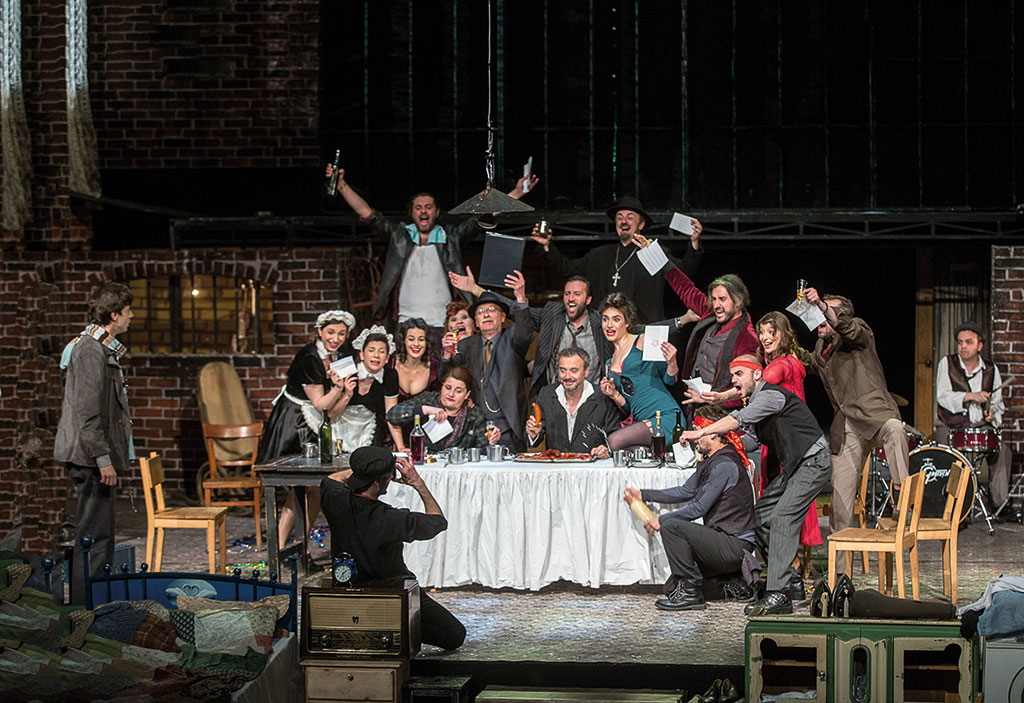
Ágnes Pálfi: The bitter irony in the title change gains meaning in the light of this closing image. Since the life presented in the play is just as remote from beauty as the protagonist, Podsekalnikov is from becoming an artist who can sound that particular tuba.
Zsolt Szász: Tranquility, however, is the existential drama of three genuine artists, at least according to the novelistic fiction. Even a system of relationships similar to that of a Greek tragedy could be constructed on the stage of the triangle of the actress mother, her violinist daughter and the would-be author, who is depicting, plus further complicating in life the conflict between them. Or, looking at it from the aspect of bourgeois drama, the conflict in Tranquility may be compared to the idea in Chekhov’s The Seagull: the outside world is unable to judge the value of talent and the accomplishment of the artist in both pieces.
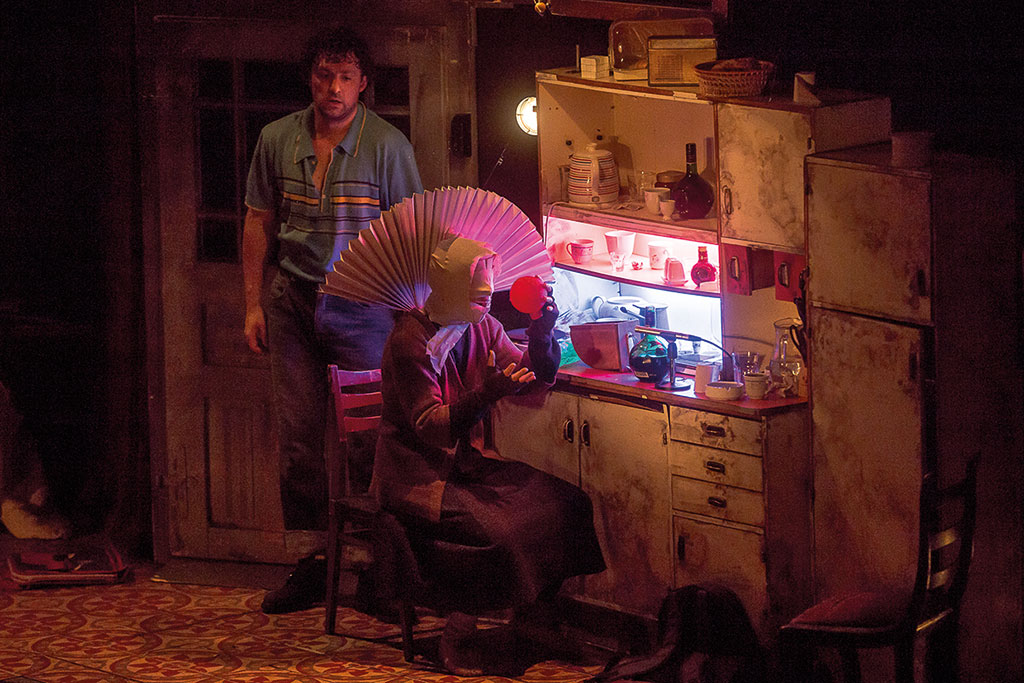
Ágnes Pálfi: But in this case it is far from obvious that the characters are destroying and grinding down one another for that reason. The excellent “civilian” acting of Erzsébet B. Fülöp, the mother, gives a vivid rendering of the process of the self-elimination of the personality, but – presumably on account of the director’s concept – she hardly shows flashes of the one-time stature of the artist. I believe it is not the boy’s mother complex but this sense of lack which is making the viewer feel embarrassed at Radu Afrim’s direction, asking: what has really been at stake in this story?
Zsolt Szász: However, it can be said of Mourning Becomes Electra by the Norwegian Theatre, Oslo, that O’Neill’s drama, on which it was based, raises a family conflict to the rank of ancient Greek tragedy which turned fatal during the American Civil War (1861–1865). The performance itself suggested, at least to me, that these worlds – of antiquity, the second half of the 19th century and the beginning of the 21st century – are light-years apart. It is as if the characters were only the narrators of the figures they were rendering, deliberately avoiding the psycho-realistic mode of acting all along. This emotionlessness was interesting for a while, but then, especially in the first part, it turned tedious.
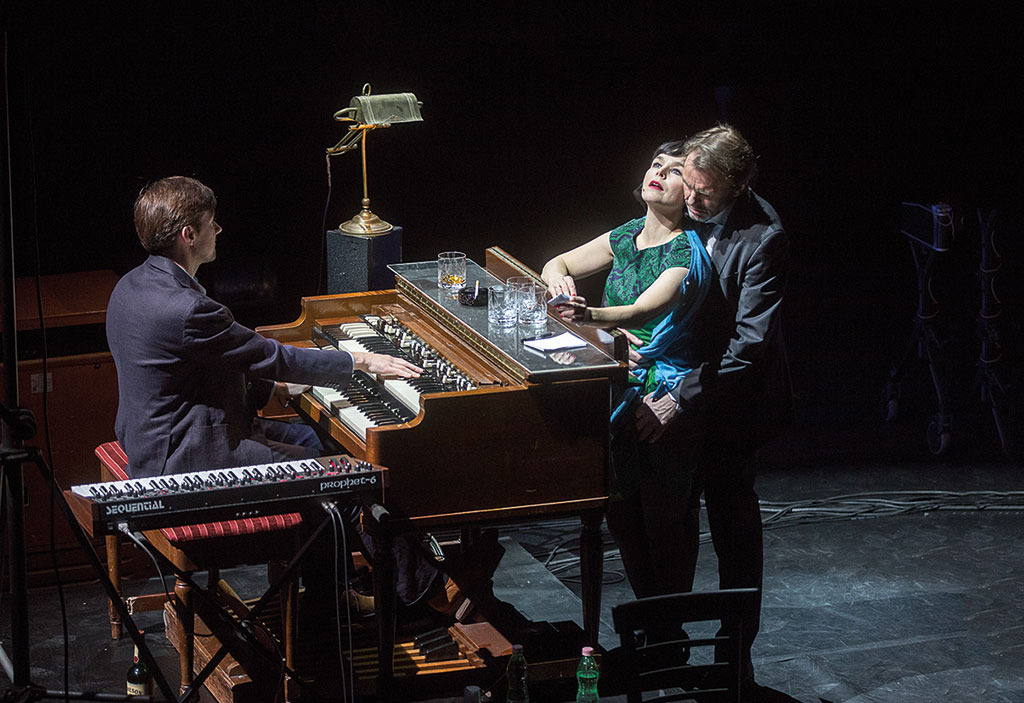
Ágnes Pálfi: This production reminds me of Hippolytus, directed now by Sándor Zsótér at the National, an unconventional adaptation of Euripides’ drama, which convinced me that such an alienating acting style is highly suited to present larger text corpora on the stage. In Electra, however, I feel it far more productive than the handling of the text that the Greek chorus is replaced with a jazz trio and that familiar rock ballads are played by the actors, articulating and liberating the suppressed instincts in this space burdened with Freudian complexes. I believe that it is by all means worth experimenting with this kind of multilingualism, which anticipates a new genre here: jazz opera.
Zsolt Szász: Hedda Gabler, directed by Anna Petterson, and the stage adaptation of Dostoevsky’s short story, The Crocodile, directed by Valery Fokin, are also interesting experiments on the symbiosis of video and theatre. The naturalistic scene setting as well as the virtual reality of the bourgeois home interior in Hedda Gabler may even remind the viewer of a soap opera on TV from which the heroine has escaped one way or another, and now, like some terrorist or even more like a gunslinger of a western film, she wants to make a showdown with those, stranded within, who messed up her life (a good question as to whether this breakthrough of dimension boundaries can succeed), before she finally kills herself.
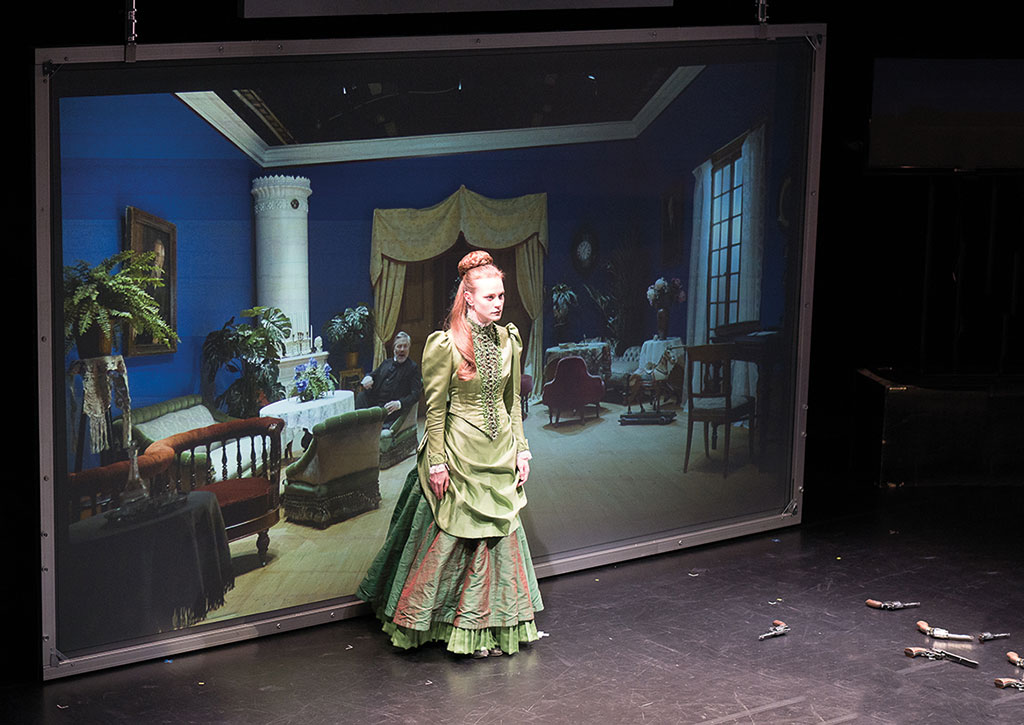
Ágnes Pálfi: What really made this production memorable to me was what the likable actress playing Hedda Gabler, Electra Hallman, said at the meet-the-artist event. It is that she had never met the actors in the video recording during the rehearsal process, while she had to be communicating with them as flesh-blood people. So when she welcomed them as acquaintances at the banquet after the premiere, they looked at her blank and misunderstood her approach.
Zsolt Szász: The little-man hero of The Crocodile is eventually released from the captivity of virtual reality, which is the belly of the beast in this case. The production opened at the National Theatre in Budapest last autumn, and ever since then I have been meditating about why no really successful performance was born of this superb directorial idea.
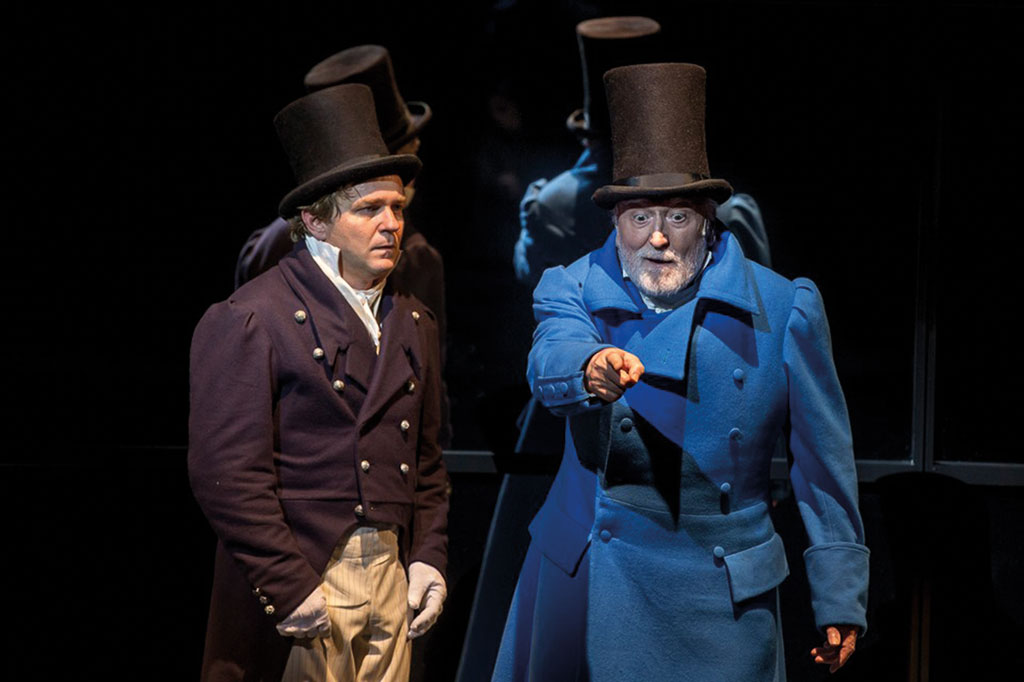
Ágnes Pálfi: If, perhaps, the scenes abundant in absurd humour had taken place in a smaller space, closer to the viewer, the excellent performance of the actors would have worked better (I was impressed most by Attila Kristán’s touching Russian little man and Auguszta Tóth’s delicately stylised acting). Smaller space would have also helped the background video-animation, which was meant to document what was happening to the insignificant little man in the crocodile’s stomach and how he turned into a significant personality, so to say. But it may well be too hard a nut to crack, and it may not be by accident that this strange short story of Dostoevsky’s has been left incomplete.
Zsolt Szász: “A hidden territory exists buried within each of us, an underground graveyard”, say the creators of the production titled The Underground: A Response to Dostoevsky.
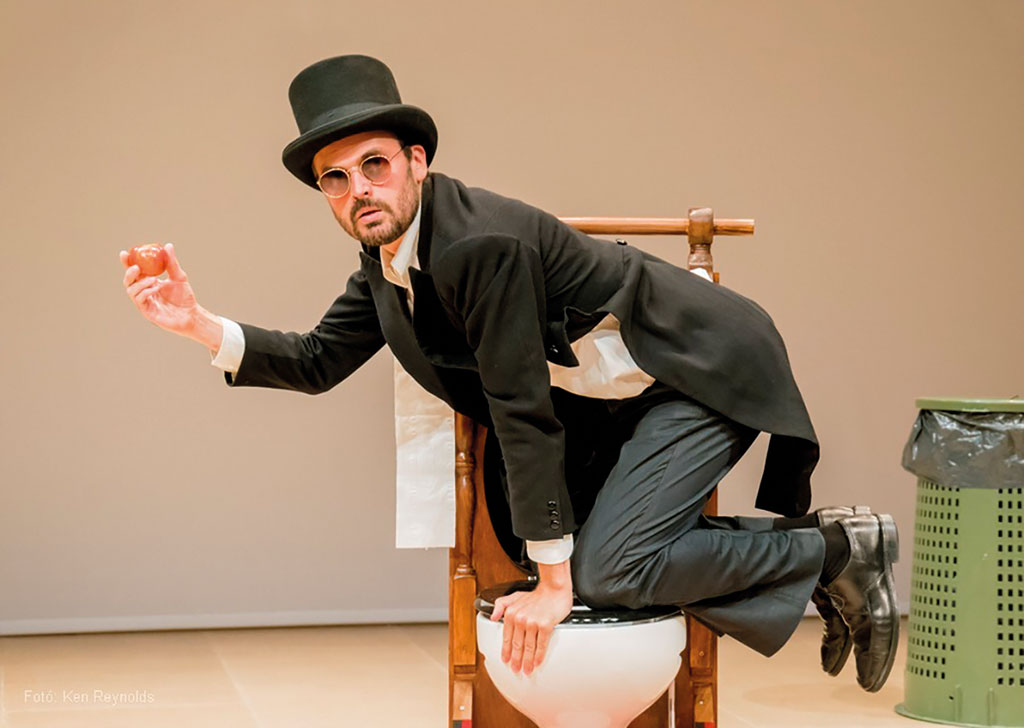
Ágnes Pálfi: Since I translated this text, I remember not at all wanting to use the Hungarian word meaning “appeal” for “response” because it would refer to a kind of debate situation. In retrospect, however, I say it might have been a better choice. For it seems as if they wished to provide a kind of prophylactic solution for all of us to rid ourselves of the psychosis of the “absorbing” attraction of this existential situation. But how does this world state concretely materialise in the production?
Zsolt Szász: We can see two statements realised on the stage: the first one is that too many ideologies are a major problem with the world, and the second one is that the financial sector is wallowing in filth. But as we have no way of confronting these forces, the solution can only be the artistic practice of self-liberation – as suggested by this performance. Continuous workshops can indeed be suitable for such a programme. Still, along with Sardar Tagirovsky, I say that “A good workshop does not guarantee creating good theatre”.
Ágnes Pálfi: In the case of Victor Ryzhakov, however, direction and instruction prove to be mutually reinforcing activities. His direction in the Budapest National Theatre repertoire, Ivan Vyrypaev’s Drunks, owes its striking success to the participation of a new breed of Hungarian actors, which allowed us to witness a sort of generational soundcheck.[3] The presentation of the piece at MITEM will also be remembered by Vitaliy Kishchenko, the actor in the Moscow production, pinch-hitting without difficulty for Zsolt Trill, who suffered an accident, in Max’s role, playing his part in Russian – for which, beyond the flexibility of the company, the credit goes to Ryzhakov as well.
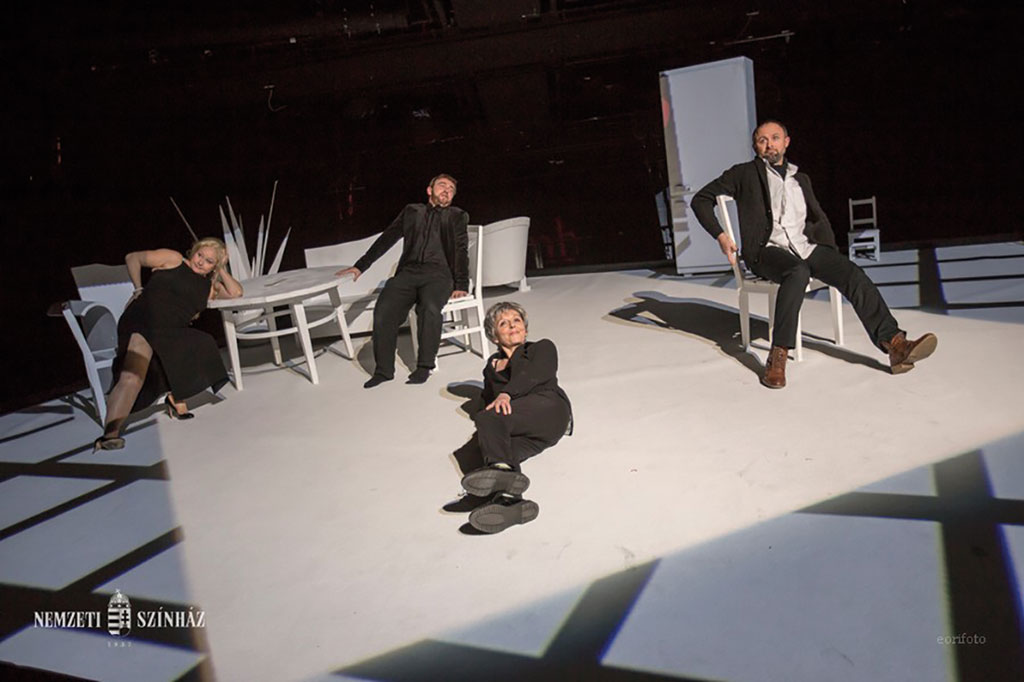
Zsolt Szász: The same Ryzhakov-students from the Moscow Art Theatre School appeared in Fro as did in Anachronistic Concert last year. Since then, this class has been transformed into an independent company as the ninth studio of MAT. Similarly to their previous “verbatim” production, this one also questions grandparents and great-grandparents’ bygone times. But now they did not have the survivors of the Great Patriotic War speak, but slipped into the skins of the twenties’ proletcult working class heroes, caricaturing the optimism which permeated even the fifties.
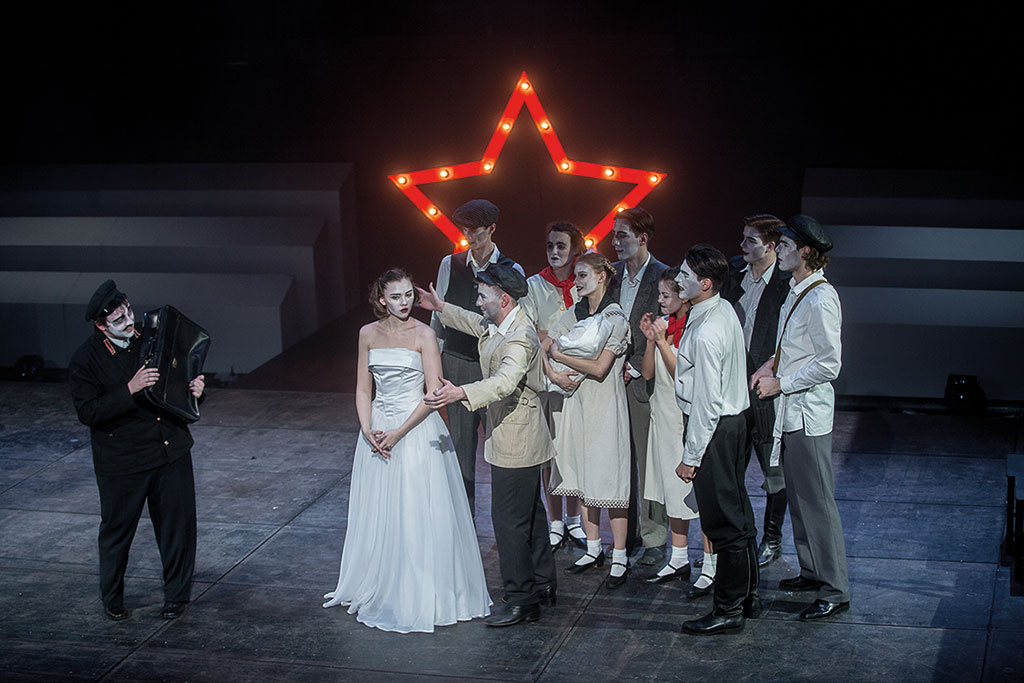
Ágnes Pálfi: This company has used film as a medium in a completely different way. First the auditorium had an air of the cinema about it: lively young faces were radiating from the film screen the ideology of schematicism: that they were living in the “the best of all possible worlds”. Only after that did the background of this poster-reality open up: the stage space where the acting of the figures painted dead-white revealed a completely different world. It is as if we were witnessing a floor show assemblage, like in Bulgakov’s novel, of absurd Gothic drama, burlesque and a clown’s buffoonery – the full range of theatrical accessories from Russian avant-garde in the beginning of the twentieth century.
Zsolt Szász: However, this maelstrom of genres in the performance has, I think, led to a decreased awareness of the kind of radical provocative attitude so characteristic of the black humour of Russian avant-garde. It also occurred to me that the director, Mikhail Rakhlin, could have been overcome by some sort of nostalgia.
Ágnes Pálfi: Anyway, I have no idea what we should call the kind of humour that was holding the entire house captive during the production of the Latvian company. Never have I laughed so hard in a theatre as during Black Milk. At the meet-the-artist event theatre historian Nina Király called director Alvis Hermanis’s production an eco-theatre. Rightly so, because its topic, obvious to everyone, is the ecological disaster threatening our entire civilization today. The “folklore” texts collected in the traditional Latvian countryside as well as the anecdotes and credible reports of the old men who were going to die all prove in the performance that this sense of catastrophe has already reached the peripheries.

Zsolt Szász: If you ask me what makes this humor irresistible, I would start from the fact that the most rewarding task for an actor is to play old men and animals. Actually, acting began with animal imitation, which served to curb larger forces than humans and to humanize the spirit world embodied in animals. Whether we know it or not, we are affected by its magic in an elementary way even today. It is enough to think of our children’s instinctive role play – true though it is that their minds are no longer occupied by domestic animals in the first place but by dinosaurs which went extinct. This experience of the animal level of existence sinks into our deep strata of consciousness before adulthood. When I am watching the adult actors playing cattle in Black Milk I am constantly switching back and forth between my rational self and the depth of my consciousness – the resulting laughter can be so unsettling because it activates this uncontrolled sphere, too. I wish we could see many similar productions at home as well!
Ágnes Pálfi: I think Asik Kerib was the only odd one out during the whole festival, eagerly awaited though – which is perhaps also due to the success of previous years’ “exotic” productions. But it has been worth seeing this Middle Eastern wayfarer’s tale for adults, too, if not for anything else but for the sake of singer-songwriter Eduard Fagimovich Latipov in the role of the spirit of the title character, giving an authentic rendering of the best of Tatars’ traditional love poetry in this bustling but pretty much patchwork-like performance.
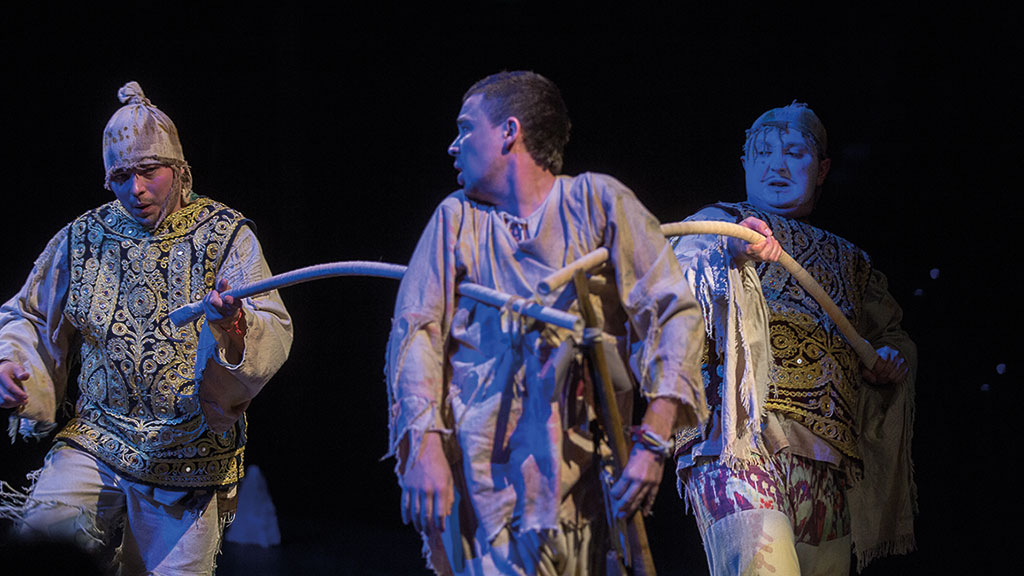
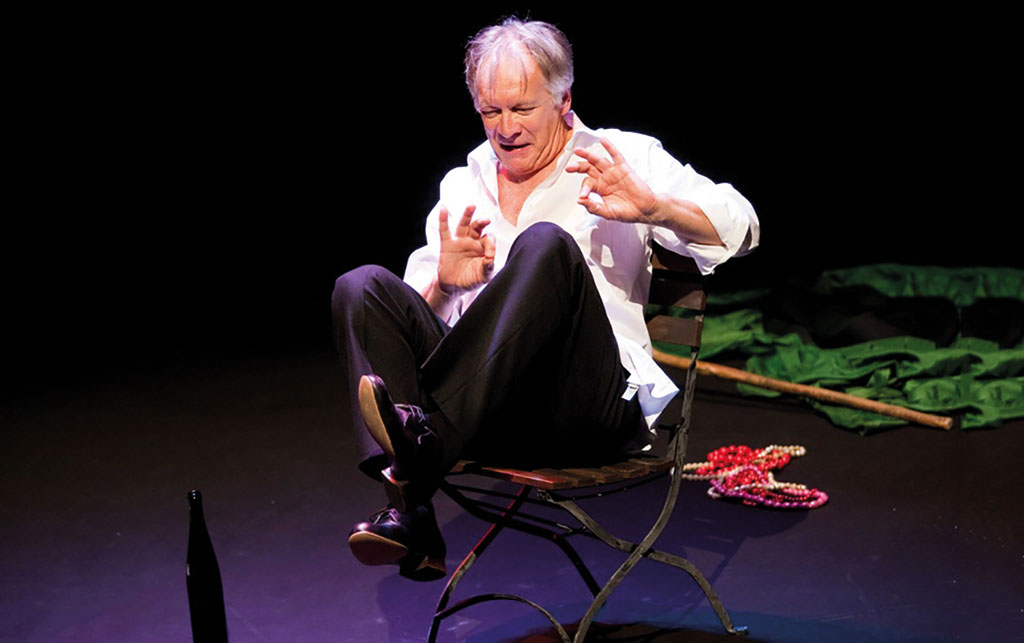
Zsolt Szász: Unfortunately, the Budapest National Theatre production of Richard III was cancelled because of Zsolt Trill’s accident. Yet, MITEM was not left without Shakespeare, thanks to world famous actor Andrzej Seweryn, director of Teatr Polski, Warsaw. As he said, he returned to his own Polish audience with this performance after a triumphant period of nearly thirty years in Comédie-Française. While I was watching the recital composed of monologues from Shakespeare’s best works, the figures of Hungarian actors like Iván Darvas, Zoltán Latinovits, Imre Sinkovits or Ferenc Bessenyi were brought to my mind. Which proves to me that these classic plays require classical rendering, labelled outdated and seen less and less nowadays, although there is continued demand for it in the audience.
***
Ágnes Pálfi: At the professional event[4] accompanying the presentation of Faust, George Banu stated that it was not necessary to know Goethe’s work to be aware of what this phenomenon was. By which he supposedly meant that – whether we want it or not – we, as Europeans, all carry the Faustian man inside. It sounded like an unchallengeable axiom, ab ovo excluding members of the audience from asking: but who is this Faust, is he still the protagonist of Purcărete’s staging at all? As a university professor I studied this theme for eleven years, and perhaps because of that I would encourage teenagers to get acquainted not only with Goethe’s work, but also with Marlowe’s and Thomas Mann’s Doctor Faustus, Bulgakov’s Master and Margarita, or even the basic work in the German Volksbuch (Folk Book) from 1587, and also – especially if one has some affinity for the theatre – with the puppet versions playing on European stages throughout centuries. Since, as we know, the young Goethe’s interest in the subject was raised by such a puppet performance.

Zsolt Szász: This production has been the largest enterprise at a Romanian theatre over the last ten years. When Nagyszeben (Sibiu) was designated the European capital of culture in 2007, two million euros of the 50 million euro budget were spent on this production alone. And indeed, an emblematic performance was born, which has since conquered the audiences of numerous big cities in Europe. Thanks to that, Romania has become a theatre giant. And the promised magic in Budapest, with Hungarian actor Miklós Bács in the title role, worked very well. Even in years to come, said one of our friends in the trade, we are going to remember this presentation as a shared experience, with all of us looking at each other differently from now on. Nevertheless, there is no denying that the production itself divided the audience as did Gulliver’s Travels at MITEM last year. Just as the unconcealed presentation of child murder and cannibalism blew a fuse there, here pedophilia and the natural act of bloody incest provoked repugnance.
Ágnes Pálfi: Actually, pedophilia is already thematised by Goethe when Faust asks Mephistopheles whether Margaret is over fourteen. But this bloody and, at the same time, absurd incest, which is committed by Mephistopheles and not by Faust with Margaret, is indeed a decisive turning point in the history of interpretations, with Purcărete radically erasing any presence of Eros from the performance. And nor is eroticism the driving force in the last scene as it is with Goethe, where Faust’s soul is saved by the spirits successfully distracting Mephistopheles’s attention on account of his sensuality. To my mind, a major component in the director’s concept is to be found in this definite move. Just as Raskolnikov tells Sonia at one point in Dostoevsky’s novel that “… it was the devil that killed that old woman, not I” so does Purcărete lift responsibility off Faust for what is happening to Margaret; since he on the stage is like one of the audience, a mere witness to this crime. I consider this interpretation overriding the moral approach to be far more unsettling and topical than for instance Michael Thalheimer’s one in 2004[5], which made Faust seem as a remorseless sex-killer with a fascist inclination.
Zsolt Szász: While keeping themselves aloof from the interpretation of the performance, the creators still disclosed at the round table discussion that Romanians, as orthodox believers, relate to the divine, diabolical and, in general, demonic spheres differently from Western Christians. By this they apparently referred to those archaic contents of consciousness which are also present in the Hungarian system of images concerning, for example, the devil (take the saying “ördöge van” meaning “he has got a devil”, which carries no negative connotations at all, but indicates surplus knowledge and creative ability). I think Mephistopheles is the protagonist of this production, since it is his vitality and surplus energy that in fact pulls the world-weary Faust, ready to kill himself, out of his apathy.
Ágnes Pálfi: This hermaphrodite and vigorous Mephistopheles reminds me of C. G. Jung’s reasoning formulated in 1947 as a result of the inevitable experiences of World War II: as long as the Evil One is mé on (non-existent), no one takes the shadow seriously. Hitler and Stalin will remain cases of a “fortuitous lack of perfection”. The future of mankind will largely depend on the recognition of the shadow. “Evil is – psychologically speaking – terribly real. It is a fatal mistake to diminish its power and reality even merely metaphysically.” Because of this, Jung proposes the extension of trinity to quaternity, since, in his view “… the opposites latent in the Godhead separate in the begetting of the Son and manifest themselves in the opposition of Christ/Devil.”[6]:
Pater
Filius + Diabolus
Spiritus
Zsolt Szász: A lifeblood of the Faust myth is that Diabolus makes a manifest appearance in it. Its stage representation moves on a wide scale from a fallen angel through “batman” to a modern, manager-like mass man. Ofélia Popii’s astonishing appearance, face covered in dead-white paint and suggestive acting can, in themselves, convince the viewer that they are capable of dominating with demonic power the sphere commonly known as hell. Moreover, she does not only appear here as the guide of Faust’s soul but also that of the audience’s souls, when she breaks through the acting area in the first part and leads us up to the backdrop of the Walpurgis Night, which is a hall-sized stage. The viewer undergoes a dual experience because while the director involves viewers in physical activity by moving them off their seats, he also alters their sense of space, and does it all so that they attribute this liberating experience to the demonic energy of Mephistopheles. This psycho-physiological change enables us to perceive with a cleansed awareness the images that Pucărete and the visual designer Helmut Stürmer are using to represent hell as the reality around us, here and now.

Ágnes Pálfi: Where everything is “what it is”, to quote Sebastian Vlad Popa in his study on Pucărete[7]. Indeed, it is a “concrete theatre”[8], with the emphasis on perception and not on interpretation. From this extended dimension, the drama of Margaret’s tragic life appears in the rear of the acting area as a comic, miniaturized scene from a puppet show. Now it is no longer this story which we perceive as reality but that closely observable mechanized world, which overbears – by its whirl and exaltation – the audience, having been sheperded in as a mass.
Zsolt Szász: I realised that the majority of spectators were fascinated above all by this carnival experience. To several of our actor colleagues this middle section of the performance felt like the harrowing of hell. I, however, as a director who celebrated festive street theatre productions of even larger scale than this, was not shocked by this stunt of Purcărete’s. At the same time, I dare say that although this demonstration did not take place under the open sky but in a devastated industrial hall, it was still able to create a similar “cosmic” experience as the natural medium. Presumably this is also why the director’s “psychotropic experiment” on viewers was successful again: when during the third section of the performance we are back on our original seats watching the denouement – the fate of Faust’s soul – in the baroque stage space, we find ourselves with an awareness, or rather sense of afterlife encoded in us. This is reinforced by the “celestial choir” present during the performance from the start, composed by Vasile Şirli of medieval musical motifs, and now it can be heard again at the end of the closing scene as a final memento – or as atonement to a house struggling with ambivalent experiences.
Ágnes Pálfi: After all, Purcărete interpreted Goethe’s work through this production, following the convention that only the first part and the final chapter of the work are fit for the stage. He is not faithful to the story, nor to the stylistic, tone-specific features of the work, but to the primeval drama within the story, which is the innermost mover of a human being; he makes visible the driving force that arises from the conflict between our subconscious instinctual life and our conscious existence. This might as well serve as a common point of view when it comes to staging Crime and Punishment, since Raskolnikov’s drama, too, stems from his courage to ask questions about the intellectual, psychological and existential motives of a human being.[9] Attila Vidnyánszky, however, does not use this perspective to approach the novel. In an interview made during the first rehearsals[10] he says that Dostoevsky’s dialogues can be presented on stage almost unchanged because they are still so vivid and relevant today.
And the production is really surprisingly close to the novel in its language, however, we cannot say that it is a mere illustration of Dostoevsky’s prose fiction.
Zsolt Szász: It is common knowledge that Dostoevsky’s works are also called novel-tragedies by literary scholars. In the case of Crime and Punishment the idea of staging emerged right after the publication of the book. The study on this dilemma of genre and poetics based on Dostoevsky’s letter of January 1872 was published in Szcenárium, February 2017. The writer warns against putting a full-length novel on stage, saying to his correspondent that it is different though if you transform the novel as much as possible and only keep an episode or its starting idea, while utterly alter the plot.[11] Because, according to Dostoevsky, it is the plot which connects most to the poetic line of thought that determines whether the work asks to be cast in a narrative or dramatic form. So, in dramatizing the narrative epic, a different kind of poetic idea is to be elaborated. Attila Vidnyánszky, apparently, has taken an approach distinct from this poetic consideration, since he has shouldered the burden of staging the novel as a whole: “now I need the epic spaciousness of time” – he said in an interview in Szcenárium.[12] After the production brought down the house in St. Petersburg, it received a standing ovation from Budapest audiences as well. Right after the performance, elite scholars of Russian studies started conferring with us about how this staging could at many points trigger the same excitement in the viewer as in the reader of the novel. Does it mean that the distinction Dostoevsky drew our attention to 150 years ago has vanished into thin air by now? Or is it the case that theatre art has evolved so far as to eliminate the genre boundaries considered Holy Writ by European aesthetics since Aristotle until recently? As for me, I doubt it. However, it is worth discussing what kind of tool kit and stage dramaturgy Attila Vidnyánszky used to stage this inticate epic construction so grandly and impressively.
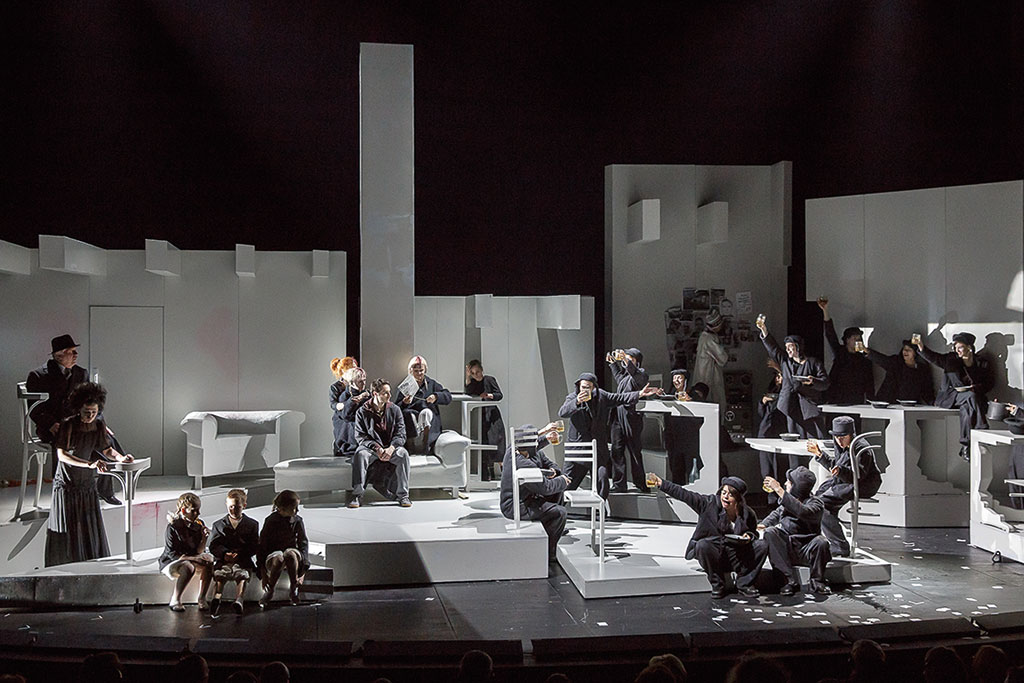
Ágnes Pálfi: The kind of dramaturgy which stages segments of reality separated in space and time simultaneously is especially well suited to this novel by Dostoevsky. Raskolnikov represents such a magnetic centre where multi-threaded life stories converge and become dialogically connected. They are mostly collated in Raskolnikov’s consciousness into a fresco demonstrating the untenability of Russian living conditions, but as the novel proceeds, there is more and more interaction going on between the characters at the level of the external story, too. This process already commences before the act, but only turns determinative when the murder has been committed, justifying in retrospect the legitimacy of Raskolnikov’s rebellious indignation. Attila Vidnyánszky blends these two time periods together: he creates a sort of dialogic medium on the stage from the start, pulls viewers into the external story right away, dispensing with the monologue-condition in which Raskolnikov’s struggles take place before he commits the crime[13], but the presence of which is made felt throughout the novel. Therefore, it is not Raskolnikov’s internal drama that is in the focus, but the stories, no less shocking, around him, which add up to a kind of ethical reading of Dostoevsky’s world of novels.[14]
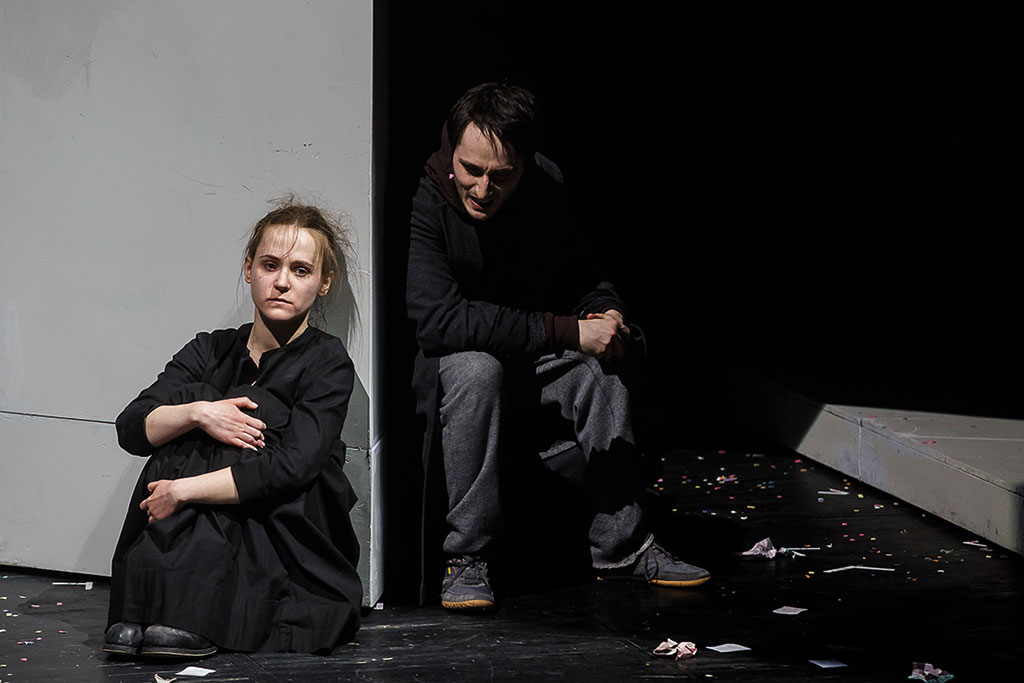
Zsolt Szász: In our interview last year, Attila highlighted that the most important thing for him in stage direction was to sort of bring the story over to the present day. As a person intimately familiar with Soviet-Russian reality, he was in fact able to create the experience of time continuity by moving about the “chorus”, recruited of young drama students. This group, dressed in shabby prisoner’s clothes and a uniform ushanka, makes the continuous Gulag-existence ever-present. In my opinion, this is the connective tissue of story-telling here, which must be resonating elementally with contemporary Russian viewers. As they are surely better at understanding the significance in this production of Raskolnikov yielding not to a worldly law court but as a conseqence of common-law convicts expelling him from among themselves as a foreign body intellectual.
Ágnes Pálfi: We know it from Dostoevsky’s memoirs that the most shocking experience of his life was not the moment in front of the execution squad but when it dawned on him in the course of his four-year detention at the Perm prison camp that the Russian intelligentsia got alienated from the people it had wanted to save with its incendiary ideas.
Zsolt Szász: I was most impressed by Raskolnikov and Porfiry’s dialogues in this production. Not only because they informed those viewers who happened to be unfamiliar with the novel of certain precedents which made Raskolnikov – at least according to the prosecutor –commit the crime. But because it is Porfiry who undergoes the most spectacular character development during the performance: the easy-going 21st century man of the world turns into a monk in the last scene where he appears with the protagonist, which indicates that he is over / on the point of a psychological change enabling him to arrive at a deeper understanding of what happened.

Ágnes Pálfi: However, we had better be careful here. It is true that the majority of interpretations reflects the directors’ conviction that Porfiry is the only person in the novel who is intellectually compatible with Raskolnikov. Yet, the ultimate explanation for the crime committed by the protagonist can no longer be found in the article he had written months before and got into the hands of the prosecutor who looks upon it as a proof of Raskolnikov’s Napoleonism. In this regard I consider it most fortunate that it is not the “novel of ideas” interpretation which dominates Vidnyánszky’s stage, but it is an ethical reading with the focus on external circumstances.
Zsolt Szász: My basic experience as a viewer was that I could see an entity, a stage work of art in its own right, also interpretable independently of the novel, in which spatial design plays a crucial role. In the opening scene, the one-piece glittering white stage setting bursts into pieces during Marmeladov’s ecstatic monologue with the audience watching, suggesting the idea of “Everything Whole is now broken” (Endre Ady: Night Wagon). The continuous tension between the parts and the whole makes both the matching and the interplay of the episodes variable, which may even be translated as the constantly changing stage set of the Tregubov couple is mapped onto Raskolnikov’s movement of consciousness. We do not perceive a step-by-step linear construction, but the dynamic interaction of stories, which, similarly to Bakhtin’s conception, draws attention to the polyphony of Dostoevsky’s novel.
Ágnes Pálfi: Eugene Onegin by Pushkin, just like Crime and Punishment, is one of the pillars of literary education in Hungary as well – even if they are not compulsory reading, these two pieces may be selected for secondary-school leaving examination topics, too. Still, it is a question how close these heroes are to the youth of today. It first occurred to me twenty years ago when one of my distinguished students (a dramaturge, theatre practitioner since) protested against having to write an essay on Onegin at the grammar school. And then years later, as a university professor already, I had to face the fact that the dilemma of Raskolnikov, the possibility or the impossibility of becoming a great person, did not really stir the imagination of humanities students (ninety percent of whom were women, of course).
Zsolt Szász: And I am curious to know how those recent drama graduates, some of whom are already members of the National’s company or cluster around Attila Vidnyánszky Jnr, director of Richard III, view these heroes, who could belong to their peer group on account of their age and who have long been on not only the Russian but also the world stage as dramatic heroes.
Ágnes Pálfi: Literary awareness has Onegin as the prototype of Oblomov, the Russian líshniy chelovék, superfluous man. Contrary to this, semiotician Yuri Lotman says that Onegin foreshadows Dostoevsky’s such rebellious “Napoleonic” heroes as Raskolnikov.[15] At the same time, re-reading Dostoevsky’s study on Pushkin for the occasion, I was astounded by the vehemence the creator of this rebellious hero is using to crush Onegin, pointing out even that the author should have made Tatyana, symbol of the Russian folk soul, the title character of his work. How do you see it? Who is the protagonist of this story with Tuminas?
Zsolt Szász: My answer is pretty unambiguous. The production shows the drama of Tatyana and not Onegin – so in this sense she is the absolute hero here. At least according to the psycho-realistic concept, which is the basis of story-telling on Tuminas’s stage, too. This is so even if Onegin outnumbers her, since there are two, or rather three actors playing his character. The presence as fiction of old Onegin serves the creation of stage reality here, paradoxically. It resembles Tadeus Kantor’s gesture directing his own performance as a conductor. It is as if the actor, Sergei Makovetsky, was both the author as well as interpreter and director of the Pushkin piece. At the meet-the-artist event following the performance, he in fact turned out to be so deeply familiar with the topic as was able to substitute Tuminas, not present, to his credit. On this occasion, the stage and civil presence of the actor combined to authenticate the particular quality, hard to describe, beyond aesthetics, which Lotman calls “the poetry of reality” apropos of this Pushkin piece.
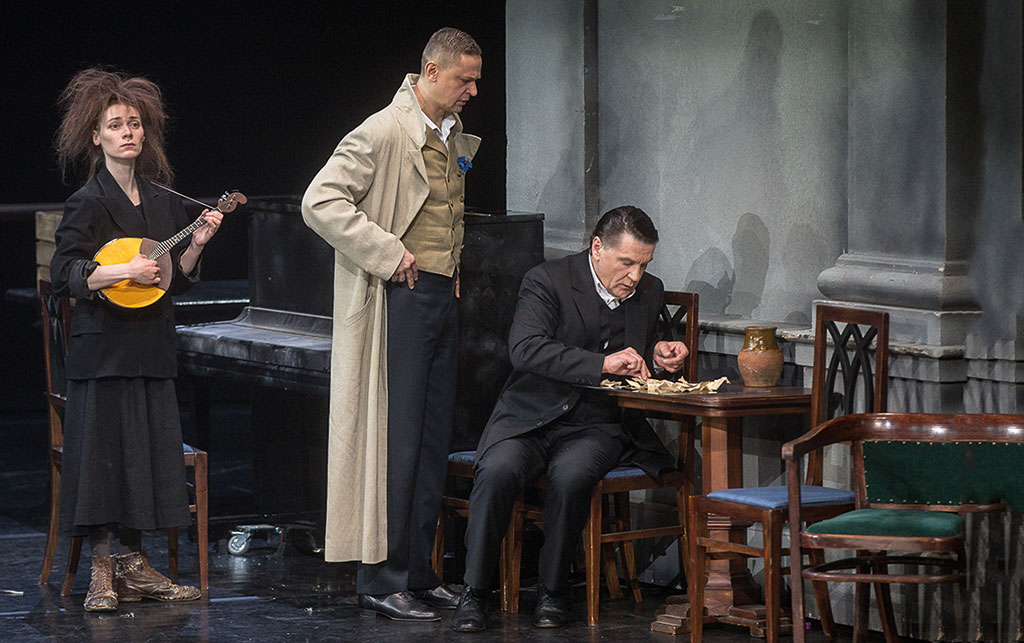
Ágnes Pálfi: I think the female side is more dominant here in numbers, too. Because beauty and aesthetics are represented here by a whole goup of ballet dancers, which, in the language of ballet, make the tenderness and sublimity of Tatyana’s psyche perceivable. In certain moments it had the same effect as Sándor Weöres’s Psziché directed by Attila Vidnyánszky, in which drama students as duplicates of the poetess formed together the female genius created by the author and made heard as “co-creator” in various tones of voice through a series of poems. To me the most memorable moment of “the poetry of reality” on Tuminas’s stage was when the books, placed on a board and opened by Tatyana one by one, began to have their pages turned as if by the wind only, sending into the sky the snow-white birds of the desire for freedom in our imagination – referring back, at the same time, to the group of ballet dancers as metaphor of the soul. And on the female side there are also elderly women showing up who, like the ballet master or the person dressed in blue, guarding the dream of Tatyana, are as much part of stage fiction as old Onegin, and can therefore be considered in a sense as the duplicates of Tatyana. In fact, they rather mark the stages of women’s life path: the death of the ballet master symbolises the end of maidenhood and the soul-killing nature of marriage without love; the woman dressed in blue in the dream scene embodies the future matron who never denies the love of her youth and keeps harbouring the mysterious dream which is to return in the surreal vision of waltzing around with the bear at the end of the performance. In this scene, Tatyana, transformed into a child, dances with the dreaded beast of her nightmares without any more fear, liberated, while the bear is commonly known to be a symbol of Russia, too.
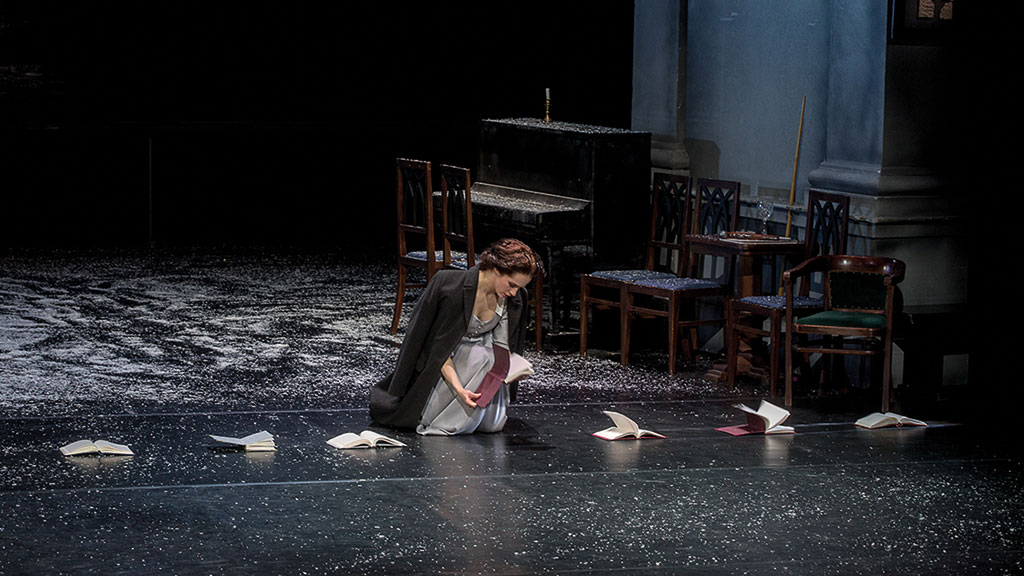
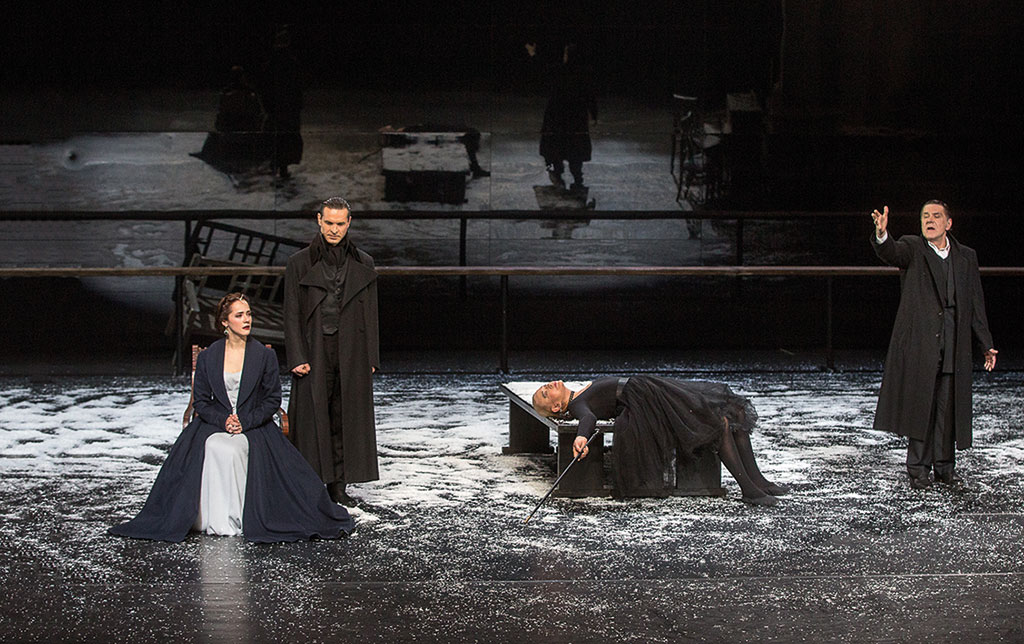
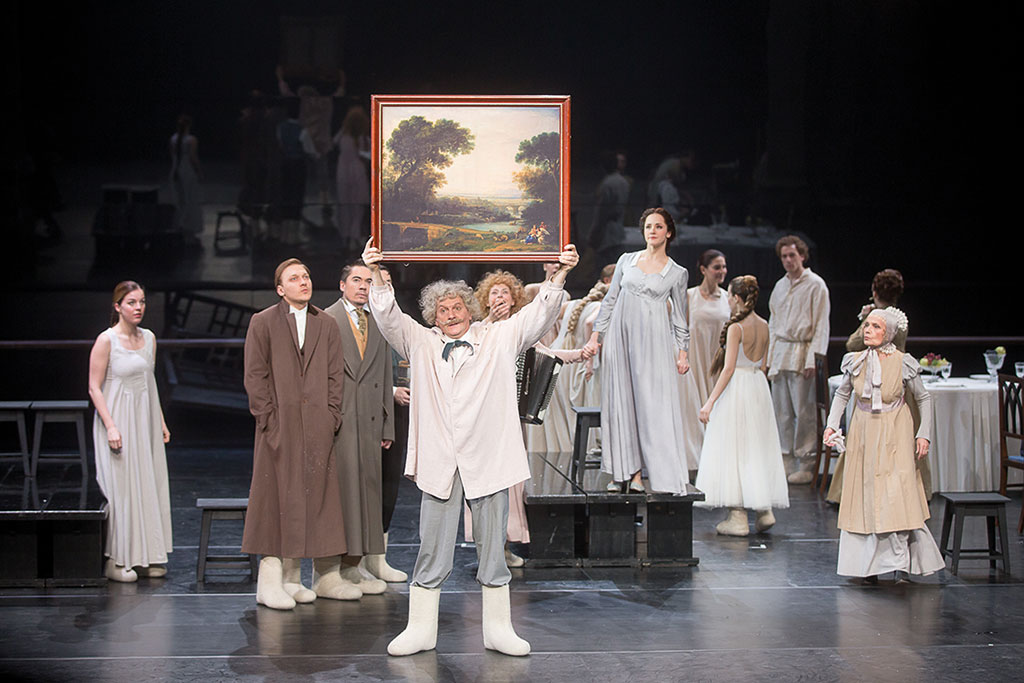
Zsolt Szász: The parodistic character of this stage direction is also worth mentioning. There is an apt term for this in Hungarian, “kifigurázás”, which is not a means of satire and devastating mockery but a special manner of character building, using the technique of overdrawing in order to capture and show the essence of a given person or phenomenon. The whole production is permeated by a particular duality: the director has the topoi of Russian national characterology come out in a procession while also developing and maintaining a self-reflective attitude, which, true to Pushkin’s work, alternately uses long-shots to alienate from this world and close-ups to pinpoint phenomena related not only to 19th century Russian reality but to the mentality of 21st century Russian man, too. The spirit of parody culminates in the scenes of the ceremony held on the occasion of Tatyana’s name day where the enthusiastic performers of amateur productions fail one by one – the faithful mirror of the snobbery of the Russian countryside stylised by appreciators of art. I also feel that this sequence of scenes is Tuminas’s confession about the theatre where you can still find the increasingly scarce family spirit as well as a sense of familiarity which preserves cultural identity.
Ágnes Pálfi: This production has been bringing down the house at the Vahtangov Theatre for four years. But if you saw one of the first performances on You Tube, you might be surprised at how striking the change in the tone of voice that took place since that time is: while parody there was much more pungent (take for instance the recitation of Tatyana’s letter in the manner of a drama exam going wrong), here, beyond the personal drama of Tatyana, the “common inspiration” holding the nation together is also manifested, attaching a new meaning to the commonplace that Eugene Onegin by Pushkin is “the encyclopedia of Russian life”.
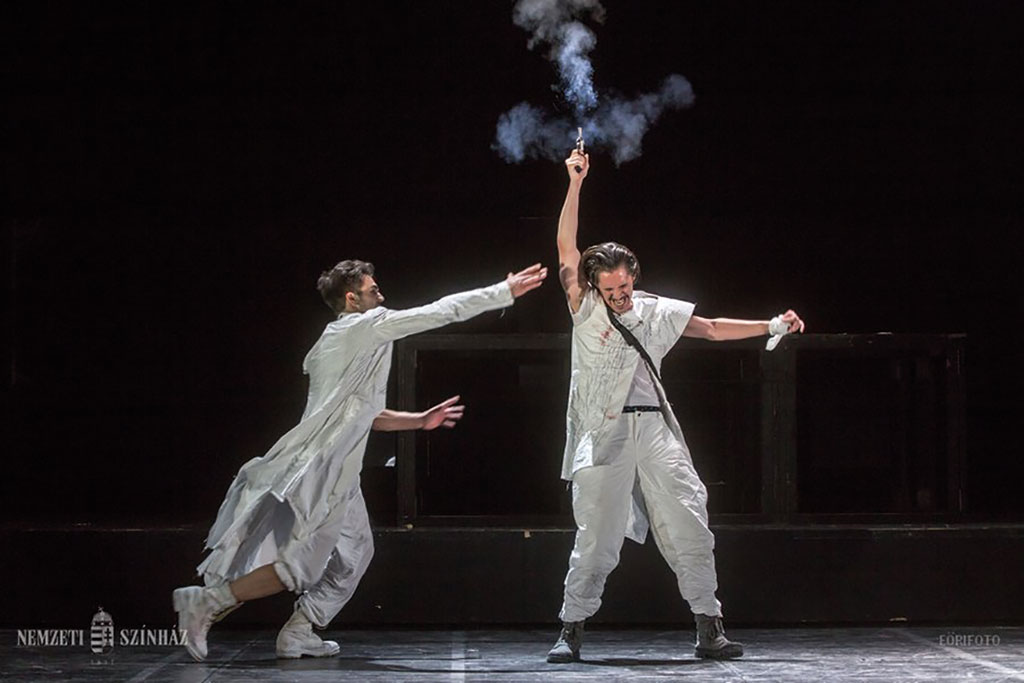
Zsolt Szász: Tuminas’s stage direction has restored the tattered dignity of Romanticism as well. Because by Lensky’s alter ego surviving the duel, the Romantic poet – Pushkin’s double – is made immortal. And perhaps Rostand’s Cyrano is worth mentioning at this point, which was presented at MITEM by David Doiashvili. The director has Christian as the alter ego of Cyrano just as Tuminas has the surviving poet. Also, the shared ’object of their love’, Roxane, is played by as many as five actresses here in respective ages and situations. The duel of the ageless men’s double appoints the greatest theme of poetry, the passion of love as the supreme motive. The entire stage is dominated by Eros, as if the full cast as well as the complete stage machinery was dynamised and filled up with energy by it.
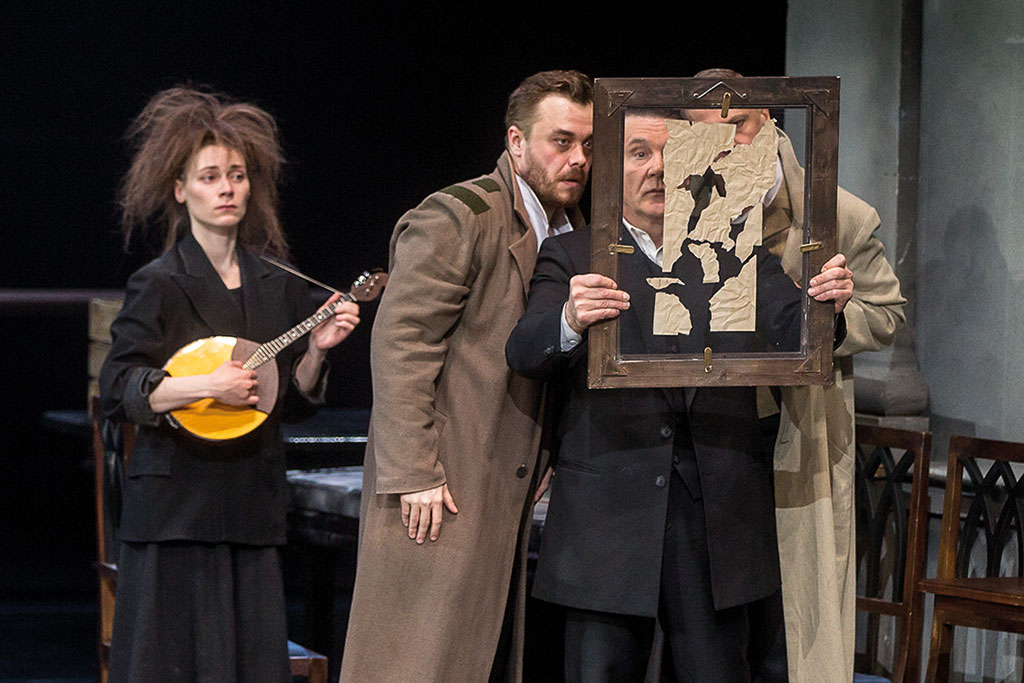
Ágnes Pálfi: As contained in Plato’s famous dialogue, Symposium, Eros is the demon of the desire for beauty and harmony. Where else would the “emotional and musical harmony” of Pushkin’s verse spring from, which Tuminas, as he stated, wanted to evoke by this stage direction of his? Although it is true that Tatyana failed to win the “mysterious object of desire”, she – as proven by her flourishing beauty – becomes an emancipated being, a mature personality through unfulfilled love.
Zsolt Szász: This is the domain that the world today is most lacking in – as indicated by the programme at this year’s MITEM as well. However, these two productions have brought the hope that contemporary theatre is to return, sooner or later, to this fountain of life.
Translated by Nóra Varga
(First publication in Hungarian: Szcenárium, May 2017, pp 17–37)
[1] One of the basic concepts of Russian formalists, often identified with the term ’alienation’. However, this is much more about capturing or extracting some from the original text context, in order to look at the elements of the text with fresh eyes, suggesting a wider range of meaning.
[2] The lead in the 1975 short film, Koplalóművész (A Hunger Artist) was played by the world-famous director of the film Szindbád (Sinbad), Zoltán Huszárik. Screenwriter and director of the film: Judit Felvidéki
[3] Discussing the production are Márta Tömöry, Ágnes Pálfi and Zsolt Szász in: ’Life-and-Death Struggle of Stage Selves at the National Theatre – Roundtable on The Drunks’, in Szcenárium, MITEM English, April 2017, pp 95–104
[4] ’Faust or Silviu Purcărete’s Poetic Theatre’. The participants of the roundtable on April 28 were: director Silviu Purcărete, scenic designer Helmut Stürmer, composer Vasile Şirli, critic George Banu and Constantin Chiriac, director of Radu Stanca National Theatre in Šibenik.
[5] The Hungarian public could see this performance in the National Theatre, Budapest, in 2006.
[6] C. G. Jung: A szellem szimbolikája, Bp., Gondolat, 1997, p 165, English in Carl Jung, Letters Vol. I, pp 539–541
[7] Cf. Sebastian Vlad Popa: A dráma celebrálása, in Szcenárium, February 2014, pp 4–15
[8] Cf. István Bessenyei Gedő: Posztdramatikus jelenségek Silviu Purcărete rendezéseiben, in Szcenárium, January 2016, p 99
[9] See Gyula Király: Dosztojevszkij és az orosz próza, Akadémiai, Budapest, 1983
[10] ’Nekem most szükségem van az idő epikus tágasságára (Vidnyánszky Attilával Szász Zsolt beszélget)’, in Szcenárium, September 2016, pp 32–40
[11] See Gyula Király: Az elbeszélői és drámai formák elhatárolásának kérdéséhez, in Szcenárium, February 2017, pp 32–41
[12] Op. cit.
[13] See Ágnes Pálfi: A belső beszéd metanyelvi funkciója a Bűn és bűnhődés narratív építkezésében, in: Studia Russica XI, 1987
[14] See Gyula Király: Az elbeszélői és drámai formák elhatárolásának kérdéséhez, in Szcenárium, February 2017, pp 177–202
[15] Jurij Lotman: A valóság költészete in Szcenárium March – April 2017, pp 64–73
(09 December 2022)











